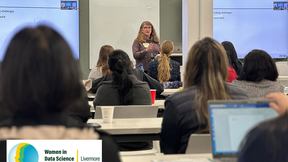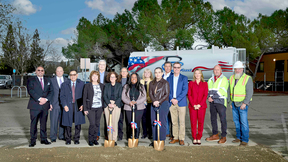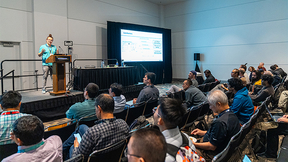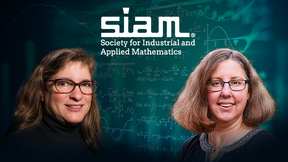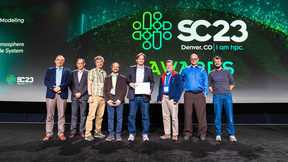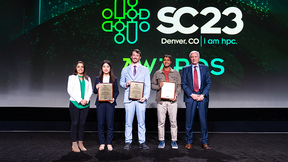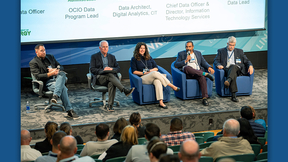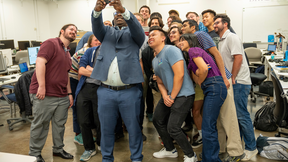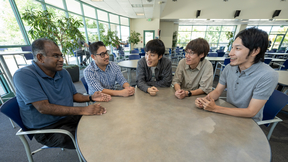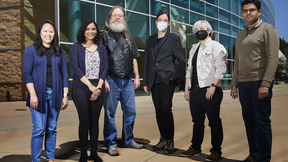Back
Researchers at Lawrence Livermore National Laboratory (LLNL) have achieved a milestone in accelerating and adding features to complex multi-physics simulations run on Graphics Processing Units (GPUs), a development that could advance high performance computing and engineering. As LLNL readies for El Capitan, the National Nuclear Security Administration’s first exascale…
The U.S. Department of Energy’s (DOE’s) High Performance Computing for Energy Innovation (HPC4EI) Program today announced the launch of its latest funding opportunity, inviting companies to propose collaborations with the DOE’s national laboratories that utilize their supercomputing resources and expertise. The HPC4EI umbrella, which includes the HPC4Manufacturing (HPC4Mfg…
Lawrence Livermore National Laboratory (LLNL) recently hosted its 7th annual Women in Data Science (WiDS) conference for data scientists, industry professionals, recent graduates and others interested in the field. As an independent satellite of the global WiDS conference celebrating International Women’s Day, the Livermore hybrid event was held to highlight the work and…
The high performance computing (HPC) publication HPCwire has selected Lawrence Livermore National Laboratory computer scientist Todd Gamblin as one of its “People to Watch” in HPC for 2024. A distinguished member of technical staff in Livermore Computing, Gamblin is best known in the HPC community for creating Spack, a popular open source HPC package management tool that…
The Department of Energy’s (DOE) High Performance Computing for Energy Innovation (HPC4EI) initiative today announced over $5 million in new funding for 13 industry partnerships, including a project led at Lawrence Livermore National Laboratory to develop more efficient optical cables. The awards, which stem from DOE’s Office of Energy Efficiency and Renewable Energy’s …
Officials with the National Nuclear Security Administration and Lawrence Livermore National Laboratory broke ground Feb. 6 on the Digital Infrastructure Capability Expansion (DICE) project, a critical upgrade for LLNL’s networking and communications. A decade in the making, the 13,000 square-foot facility is scheduled for completion in June 2025. It will provide LLNL with…
The Innovation and Partnerships Office (IPO) has launched a new software licensing portal to facilitate the adoption of the diverse proprietary software solutions developed by Lawrence Livermore National Laboratory (LLNL) researchers. The portal is another outlet from IPO to promote technology transfer through partnerships and licensing opportunities to the private sector…
A Lawrence Livermore National Laboratory (LLNL)-led team has developed a method for optimizing application performance on largescale graphics processing unit (GPU) systems, providing a useful tool for developers running on GPU-based massively parallel and distributed machines. A recent paper, which features four LLNL co-authors, describes a mechanism called Record-Replay …
The Society for Industrial and Applied Mathematics (SIAM) announced the election of Lawrence Livermore National Laboratory computational mathematician Carol Woodward as its president-elect and LLNL computational scientist Judy Hill as a council member for the organization. SIAM is a renowned international community with more than 14,000 applied mathematicians,…
The crowds returned to SC, and with them came a renewed excitement for the future of high performance computing (HPC). A record number of attendees — more than 14,000 — experts, researchers, vendors and enthusiasts in the field of HPC descended on the Mile High City for the 2023 International Conference for High Performance Computing, Networking, Storage and Analysis,…
The IEEE Computer Society on Nov. 16 presented Lawrence Livermore National Laboratory (LLNL)’s Johannes Doerfert with its IEEE-CS Technical Community on High Performance Computing (TCHPC) Early Career Researchers Award for Excellence in High Performance Computing. Doerfert, a computer scientist in the Center for Applied Scientific Computing at LLNL, was one of three…
Three of the newest National Nuclear Security Administration (NNSA) commodity computing clusters recently deployed at Lawrence Livermore National Laboratory (LLNL) and Sandia National Laboratories (Sandia) are among the most powerful supercomputing systems in the world, Top500 organizers announced Monday. Funded under the second Commodity Technology Systems contract (CTS-2…
Data researchers, developers, data managers and program managers from the Department of Energy (DOE) national laboratories visited Lawrence Livermore National Laboratory (LLNL) Oct. 24-26 to discuss the latest in data management, sharing and accessibility at the 2023 DOE Data Days (D3) workshop. The three-day event, sponsored by the National Nuclear Security Administration…
The Institute of Electrical and Electronics Engineers (IEEE), the world’s largest technical professional organization, has elevated Lawrence Livermore National Laboratory research staff member Bhavya Kailkhura to the grade of senior member within the organization. IEEE has more than 427,000 members in more than 190 countries, including engineers, scientists and allied…
Each year, Lawrence Livermore National Laboratory (LLNL) offers students the opportunity to join the Cyber and Critical Infrastructure Summer Institute (CSI) for an internship working on LLNL’s cybersecurity and critical infrastructure projects. “CSI is for both cyber and non-cyber students. It demonstrates to interns that protecting our critical infrastructure and other…
Lawrence Livermore National Laboratory’s Data Science Summer Institute (DSSI) hosted summer student interns from Japan on-site for the first time, where the students worked with Lab mentors on real-world projects in artificial intelligence (AI)-assisted bio-surveillance and automated 3D printing. From June to September, the three students — Raiki Yoshimura, Shinnosuke…
Lawrence Livermore National Laboratory (LLNL) today announced that Grace Gu, a faculty member in mechanical engineering at the University of California (UC), Berkeley, has been selected as the inaugural recipient of the LLNL Early Career UC Faculty Initiative. The initiative is a joint endeavor between LLNL’s Strategic Deterrence Principal Directorate and UC national…
The High Performance Computing for Energy Innovation program will be hosting a special in-person workshop to discuss further deployment of high performance computing (HPC) to advance manufacturing on Oct. 18-19 at Lawrence Livermore National Laboratory’s (LLNL) University of California Livermore Collaboration Center (UCLCC) The workshop will explore future developments in…
Lawrence Livermore National Laboratory (LLNL) scientists and engineers have netted three awards among the top 100 inventions worldwide. The trade journal R&D World Magazine recently announced the winners of the awards, often called the “Oscars of innovation,” recognizing new commercial products, technologies and materials that are available for sale or license for…
A team from Lawrence Livermore National Laboratory (LLNL) and seven other Department of Energy (DOE) national laboratories is a finalist for the new Association for Computing Machinery (ACM) Gordon Bell Prize for Climate Modeling for running an unprecedented high-resolution global atmosphere model on the world’s first exascale supercomputer. The Gordon Bell submission, led…



